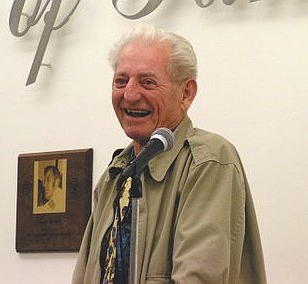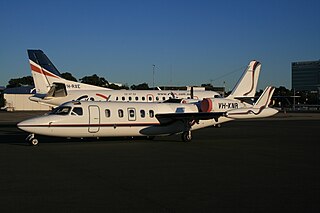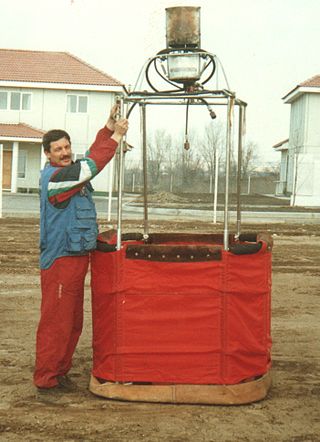
A hot air balloon is a lighter-than-air aircraft consisting of a bag, called an envelope, which contains heated air. Suspended beneath is a gondola or wicker basket, which carries passengers and a source of heat, in most cases an open flame caused by burning liquid propane. The heated air inside the envelope makes it buoyant, since it has a lower density than the colder air outside the envelope. As with all aircraft, hot air balloons cannot fly beyond the atmosphere. The envelope does not have to be sealed at the bottom, since the air inside the envelope is at about the same pressure as the surrounding air. In modern sport balloons the envelope is generally made from nylon fabric, and the inlet of the balloon is made from a fire-resistant material such as Nomex. Modern balloons have been made in many shapes, such as rocket ships and the shapes of various commercial products, though the traditional shape is used for most non-commercial and many commercial applications.

Moorabbin Airport is a mostly general aviation airport for light aircraft located in between the southern Melbourne suburbs of Heatherton, Cheltenham, Dingley Village and Mentone. It also receives commercial airline service. The airport grounds are treated as their own suburb, and share the postcode 3194 with the neighbouring suburb of Mentone. With a total of 274,082 aircraft movements, Moorabbin Airport was the second busiest airport in Australia for the calendar year 2011.

In aeronautics, a balloon is an unpowered aerostat, which remains aloft or floats due to its buoyancy. A balloon may be free, moving with the wind, or tethered to a fixed point. It is distinct from an airship, which is a powered aerostat that can propel itself through the air in a controlled manner.

A hopper balloon is a small, one-person hot air balloon. Unlike a conventional hot air balloon where people ride inside a basket, there is no basket on a hopper balloon. Instead, the hopper pilot usually sits on a seat or wears a harness similar to a parachute harness. Hoppers are typically flown for recreation. These aircraft are sometimes called "cloud hoppers" or "cloudhoppers". However, these terms formally refer to the products of a particular manufacturer, specifically Lindstrand Balloons. Nonetheless, "cloudhopper" is used by many people as a genericized trademark, which refers to all craft of this general type. Most hopper balloons have envelopes that range in volume from 14,000 to 35,000 cubic feet and have a maximum flight duration of 1 to 1.5 hours. The two principal commercial balloon manufacturers today offering hopper balloons for sale are Cameron Balloons and Lindstrand Balloons. Most other hopper balloons are experimental aircraft designed and built by amateur constructors.

Paul Edward Yost was the American inventor of the modern hot air balloon and is referred to as the "Father of the Modern Day Hot-Air Balloon." He worked for a high-altitude research division of General Mills in the early 1950s until he left to establish Raven Industries in 1956, along with several colleagues from General Mills.

Hot air ballooning is the recreational and competitive adventure sport of flying hot air balloons. Attractive aspects of ballooning include the exceptional quiet, the lack of a feeling of movement, and the bird's-eye view. Since the balloon moves with the direction of the winds, the passengers feel absolutely no wind, except for brief periods during the flight when the balloon climbs or descends into air currents of different direction or speed. Hot air ballooning has been recognized by Fédération Aéronautique Internationale (FAI) as the safest air sport in aviation, and fatalities in hot air balloon accidents are rare, according to statistics from the National Transportation Safety Board (NTSB).

Connellan Airways was an airline headquartered in Alice Springs, Australia. It operated scheduled flights as well other air transport services throughout the Northern Territory from 1939 to 1980.

The history of ballooning, both with hot air and gas, spans many centuries. It includes many firsts, including the first human flight, first flight across the English Channel, first flight in North America, and first aircraft related disaster.

On 4 September 2000, a chartered Beechcraft 200 Super King Air departed Perth for a flight to the mining town of Leonora, Western Australia. The aircraft crashed near Burketown, Queensland, Australia, resulting in the deaths of all eight occupants. During the flight, the aircraft climbed above its assigned altitude. When air traffic control (ATC) contacted the pilot, the pilot's speech had become significantly impaired, and he was unable to respond to instructions. Three aircraft intercepted the Beechcraft, but were unable to make radio contact. The aircraft continued flying on a straight north-easterly heading for five hours, before exhausting its fuel and crashing 40 mi (65 km) south-east of Burketown. The crash became known in the media as the "ghost flight".

Les Frères Robert were two French brothers. Anne-Jean Robert (1758–1820) and Nicolas-Louis Robert (1760–1820) were the engineers who built the world's first hydrogen balloon for professor Jacques Charles, which flew from central Paris on 27 August 1783. They went on to build the world's first manned hydrogen balloon, and on 1 December 1783 Nicolas-Louis accompanied Jacques Charles on a 2-hour, 5-minute flight. Their barometer and thermometer made it the first balloon flight to provide meteorological measurements of the atmosphere above the Earth's surface.

The 2009 Pel-Air Westwind ditching or Norfolk Island ditching was an aircraft accident on 18 November 2009 near Norfolk Island, Australia. A Westwind II jet operated by Pel-Air was conducting an air ambulance flight for CareFlight International when it was forced to ditch after being unable to land in bad weather and not having sufficient fuel to divert to an alternate destination.

FireFly Balloons is an American hot air balloon manufacturer that started as The Balloon Works (TBW) in 1972 in Statesville, NC. The company is one of the oldest hot air balloon manufacturers in the United States, behind Raven Industries, SEMCO and Piccard Balloons. The origins of the company's designs can be traced to the work of Tracy Barnes in the late 1960s.

On 7 January 2012, a scenic hot air balloon flight from Carterton, New Zealand, collided with a high-voltage power line while attempting to land, causing it to catch fire, disintegrate and crash just north of the town, killing all eleven people on board.
On 23 August 2012, a hot air balloon on a commercial sightseeing flight crashed in stormy weather on the Ljubljana Marsh in central Slovenia, killing 6 of the 32 people on board.

On 26 February 2013, a hot air balloon crashed near Luxor, Egypt, killing 19 out of the 21 people on board. A fire developed in the basket due to a leak in the balloon's gas fuel system, causing the balloon to deflate mid-air and crash to the ground.

Victor Zagainov was a hot air balloon pilot and astronomer from Kazakhstan. He was the first and only hot air balloon champion of the USSR (1991), Hot Air Balloon champion of the Republic of Kazakhstan (1993), the winner of the International Balloon Grand Prix Todi (Italy) (1993), the champion of the CIS (1996). He organized Grand Prix of Zagainov and was awarded Fédération Aéronautique Internationale (FAI) Diploma for Outstanding Airmanship and the FAI Air Sport Medal in 2003.

Whyalla Airlines Flight 904 was a scheduled commuter flight, operated by a Piper PA-31 Navajo which crashed while attempting to ditch in the Spencer Gulf, South Australia after suffering failures of both engines on the evening of 31 May 2000. All 8 people on board the aircraft were killed as a result of the accident. The findings of a subsequent investigation by the Australian Transport Safety Bureau highlighting the airline's operating procedures as a key factor leading to the accident were later overturned after they were contradicted by evidence presented at a coronial inquiry into the deaths of those on board the flight. The safety implications arising from the accident were subject to a recall by engine manufacturer Textron Lycoming which saw close to 1000 aircraft grounded worldwide while defects were rectified at an estimated cost of $A66 million. Australia's aviation regulator, the Civil Aviation Safety Authority also mandated lifejackets be carried on all aircraft operating over water after the crash.
On July 30, 2016, sixteen people were killed when the hot air balloon they were riding in struck power lines, crashed and caught fire in the unincorporated community of Maxwell, near Lockhart, Texas, 30 miles (50 km) south of the state capital Austin. It is the deadliest ballooning disaster to ever occur in the United States.
















